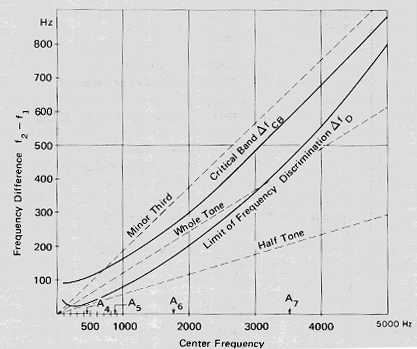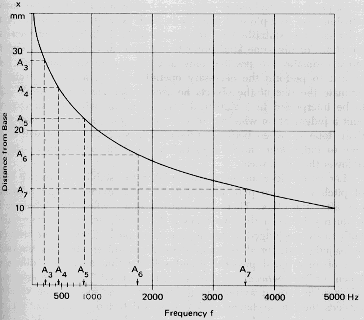Limits
The limits for pitch discrimination and the critical band depend strongly on the
centre frequency (the average frequency ![]() of the two tone stimuli. They are both relatively
independent of amplitude, but may vary considerably from individual to individual.
of the two tone stimuli. They are both relatively
independent of amplitude, but may vary considerably from individual to individual.
The critical band is related to several psychoacoustical phenomena. The following
figure shows the dependence of pitch discrimination ![]() fD and critical band
fD and critical band ![]() fCR with the centre frequency of the component
tones.
fCR with the centre frequency of the component
tones.

From this graph we can see for instance that two tones in the region of 2 KHz must be at least 200 Hz apart to be discriminated, and more than 300 Hz apart to sound "smoothly".
Notes
1. That the limit of pitch discrimination is larger than a 1/2 tone and even larger than a whole tone at both audio frequency extremes.
2. That in the higher frequency range the critical band lies between the frequency difference that corresponds to a whole tone ( dissonance) and that of a minor third (consonance) i.e. roughly extending over 1/3 of an octave.
3. In the lower frequency range frequency discrimination and critical band are larger than a minor third (and even a major third). This is why intervals of thirds in general are not used in the deep bass register in tonal music.
4. In comparing figure 2.13 with 2.9 the limit for frequency discrimination ![]() fD is roughly 30
times larger than the JND for frequency resolution. i.e we can detect very minute
frequency changes in a single sine tone, but it takes an appreciable frequency difference
between two pure tones sounding simultaneously to hear out each component separately.
fD is roughly 30
times larger than the JND for frequency resolution. i.e we can detect very minute
frequency changes in a single sine tone, but it takes an appreciable frequency difference
between two pure tones sounding simultaneously to hear out each component separately.
5. When each one of the two tones f1 and f2 is fed binaurally into a different
ear the primary beat or roughness sensation disappears at once and both tones can
be discriminated even if the frequency difference is way below ![]() fD. When we switch back to monaural
input the beats or roughness come back. What is happening in the binaural case is
that there is only one activated region of each basilar membrane with no chance for
overlapping signals in the cochlea.
fD. When we switch back to monaural
input the beats or roughness come back. What is happening in the binaural case is
that there is only one activated region of each basilar membrane with no chance for
overlapping signals in the cochlea.
The experimental fact that the critical band frequency extension ![]() fCD is roughly speaking independent
of loudness is a strong indication that it must be related to some inherent property
of the organ of Corti on the basilar membrane rather than the waveform in the cochlear
fluid.
fCD is roughly speaking independent
of loudness is a strong indication that it must be related to some inherent property
of the organ of Corti on the basilar membrane rather than the waveform in the cochlear
fluid.
By converting this frequency extension ![]() fCB into spatial extension along the basilar membrane (using
fig 2.8) we can see that the critical band
fCB into spatial extension along the basilar membrane (using
fig 2.8) we can see that the critical band ![]() fCB is an almost constant value of approximately 1.2 mm.
Also, this section of basilar membrane is "serviced" by a roughly constant
number of about 1,300 (out of 30,000) receptor cells independently of any particular
centre frequency (i.e. independent of the position on the membrane.)
fCB is an almost constant value of approximately 1.2 mm.
Also, this section of basilar membrane is "serviced" by a roughly constant
number of about 1,300 (out of 30,000) receptor cells independently of any particular
centre frequency (i.e. independent of the position on the membrane.)
